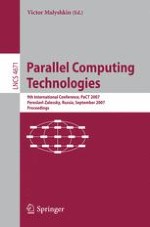2007 | Buch
Parallel Computing Technologies
9th International Conference, PaCT 2007, Pereslavl-Zalessky, Russia, September 3-7, 2007. Proceedings
herausgegeben von: Victor Malyshkin
Verlag: Springer Berlin Heidelberg
Buchreihe : Lecture Notes in Computer Science
